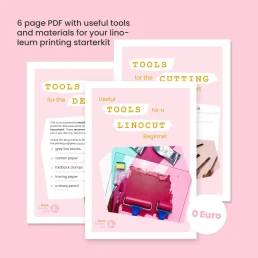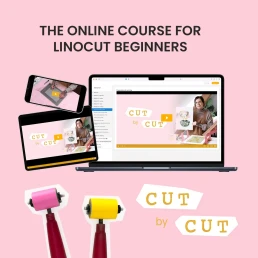
Linocut Tools for Beginners – Save Money on Your Starter Kit
Discover which linocut tools are worth investing in and where you can save money as a beginner. Build your starter kit without overspending.
I will help you understand linocut printing step by step, try it out for yourself, and create your own prints.
Which tools does a linocut beginner actually need? When you’re just starting out, you probably don’t want to spend a fortune — and definitely don’t want to buy the wrong materials. Still: don’t skimp in the wrong places!
Cheap tools can quickly become frustrating because they’re harder to handle and give worse results.
From many of my own attempts I know: dull knives, hard lino blocks, or unsuitable inks lead to messy prints — and sometimes even to injuries. The best solution is a mix of beginner and pro tools.
In this article you’ll learn where you can save money and when an investment is worth it.
If you’d rather get started right away: 👉 Download my free tool checklist for your linocut starter kit here!
Linocut Carving Tools
A good carving knife is the heart of your linocut kit. Dull or cheap knives make carving dangerous and imprecise.
These three blades are totally enough to start with:
-
Medium V-gouge: For fine lines and deep grooves
-
Wide U-gouge: For clearing larger areas
-
Flat gouge: Versatile and forgiving
Save or invest?
💡 Invest! Cheap sets dull quickly and usually can’t be sharpened. Good knives stay sharp for years and make carving safer and more precise. My favorite are Pfeil tools
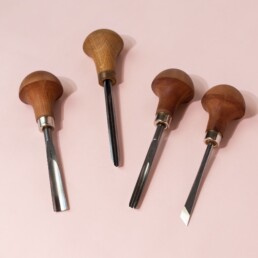
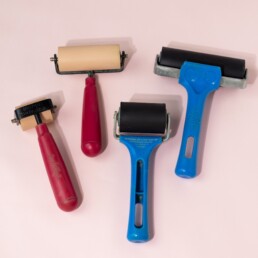
Ink rollers
When it comes to ink rollers, I recommend striking a balance. I use soft rubber rollers because they distribute the ink evenly and are easy to use.
Tip: Two or three rollers are enough to start with—one narrow and one medium width. If you mainly work in A4 format, you don’t need a larger one.
Save or invest?
💡 Better to invest. I wouldn’t recommend the rollers with the round steel frame from ABIG, for example. Instead, the Speedball deluxe soft paint rollers are fantastic, and the even cheaper soft rubber rollers from Essdee UK are also great to work with.
Relief Ink
My most important tip: use oil-based, washable linocut inks.
Water-based inks dry extremely fast — especially in warm conditions — and make printing multiple impressions difficult.
My favorite: Caligo Safe Wash Relief Ink (Cranfield Colours)
-
Cleans easily with water & soap
-
Excellent printing properties
-
Silky-matte finish
Save or invest?
💡 Invest! Good ink is key to clean prints. For years, I have been working exclusively with Cranfield’s Caligo Safe Wash Relief Ink.
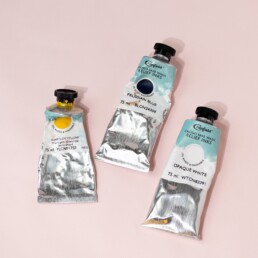

Paper
Expensive paper isn’t necessary. For starting out, smooth, easy-to-print paper is enough. I use, for example, 160 g/m² Design Offset White, which is also used for flyers and magazines. However, I buy that from a local print shop.
Tip: The heavier or more textured the paper, the harder it is to print — especially without a press. Smooth paper is ideal for beginners.
Save or invest?
💡 Saving is fine! Start with affordable paper and move to handmade or specialty paper once you have more experience.
Linoleum Blocks – Classic Remains Favorite
My favorite is classic grey lino, often called Battleship Grey. It smells nice, cuts well and gives the typical linocut feel. Other variants like brown lino or softcut/vinyl behave differently when cutting and feel different.
Save or invest?
💡 Invest moderately! Classic linoleum from Essdee UK is my favorite. But you definitely need sharp carving tools for this!
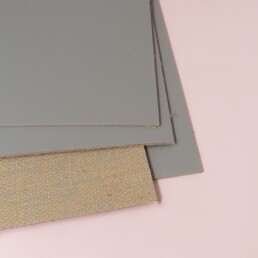
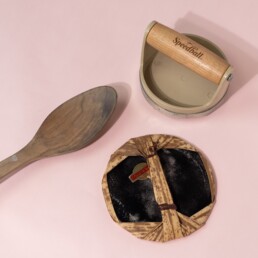
Barens & Wooden Spoon – Printing Without a Press
If you don’t own a press, you can still get lovely impressions using a wooden spoon or a Japanese baren. It takes a bit longer, but it works wonderfully — especially for small formats.
Save or invest?
💡 Saving is fine! A wooden spoon is often completely sufficient. A baren is a nice addition!
Conclusion – Where to Save and Where to Invest
Don’t save on carving tools and ink – these make the difference between fun and frustration.
You can save on rollers, paper, and barens.
As for lino: traditional grey combined with sharp tools is the perfect match for great results.
With the right tools, linocut printing becomes pure joy, and you’ll achieve good results quickly. That way, you’ll stay motivated and avoid unnecessary frustration.
I can help you in two ways:
👉 Download my free tool checklist to find a selection of products that are perfect for beginners.
👉 Or jump right in with my online linocut course, where I show you every step in easy-to-follow video lessons.

